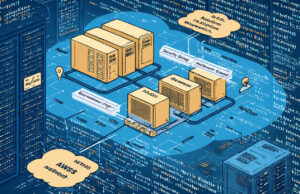Ever tried explaining to your mom why Netflix buffers but YouTube doesn’t? Welcome to the invisible world of network protocols – the digital traffic cops determining if your data zips along an expressway or crawls through back alleys.
Every single byte of data moving across the internet follows specific network protocols that dictate how devices communicate. Without these standardized rules, your smartphone couldn’t talk to your router, which couldn’t connect to Facebook’s servers.
Think of protocols as different languages. Some are simple and universal (like HTTP), while others are specialized for specific tasks (like SMTP for email). Understanding these network protocols isn’t just for IT pros anymore.
But here’s what most explainers miss about protocols – they’re not just technical standards. They’re the product of decades of digital evolution, each with its own fascinating origin story.
The Fundamentals of Network Protocols
What Are Network Protocols and Why They Matter
Ever tried talking to someone who doesn’t speak your language? That’s what devices face without protocols. Network protocols are simply the rules that govern how data moves between devices. Without them, your laptop couldn’t chat with servers, your phone wouldn’t connect to Wi-Fi, and the internet as we know it wouldn’t exist.
Key Network Protocols You Should Know
Key Network Protocols You Should Know
A. TCP/IP: The Backbone of Internet Communication
Ever wonder how your cat video makes it from a server in Tokyo to your phone in seconds? That’s TCP/IP working its magic. This protocol suite handles the heavy lifting of internet communication, breaking data into packets, routing them across networks, and reassembling them perfectly on your device.
B. HTTP/HTTPS: Powering Your Web Browsing Experience
HTTP is like the friendly courier of the internet. It delivers web pages to your browser when you type in a URL. HTTPS adds a security jacket to this courier, encrypting the data so nobody can peek at your passwords or credit card details as they travel across the web.
C. DNS: Translating Domain Names to IP Addresses
DNS is basically the internet’s phonebook. You type “facebook.com” because it’s easy to remember, but computers need numbers like 69.63.176.13. DNS translates these human-friendly domain names into machine-readable IP addresses, saving you from memorizing numbers for every website you visit.
D. DHCP: Automating Network Configuration
DHCP is that invisible hero that saves you from technical headaches. When you connect to a network, it automatically assigns your device an IP address, subnet mask, and default gateway. Without it, you’d need to manually configure these settings every time you join a new WiFi network.
E. SMTP, POP3, and IMAP: Making Email Communication Possible
These three protocols are why your emails actually reach their destination. SMTP handles outgoing mail like a postal service. POP3 downloads emails to your device and typically deletes them from the server, while IMAP keeps everything synchronized across all your devices so you can check emails anywhere.
Wireless Communication Protocols
Wi-Fi (IEEE 802.11): Enabling Wireless Internet Access
Ever tried to imagine life without Wi-Fi? Nightmare, right? This ubiquitous protocol (formally known as IEEE 802.11) revolutionized how we connect to the internet. Operating primarily in the 2.4GHz and 5GHz frequency bands, Wi-Fi creates invisible networks that blanket our homes, offices, and favorite coffee shops. The latest Wi-Fi 6 standard delivers speeds up to 9.6 Gbps—that’s crazy fast compared to the measly 11 Mbps of the original standard.
Bluetooth: Connecting Devices at Short Range
Bluetooth technology is that quiet hero working behind the scenes in your daily life. Named after a 10th-century Danish king (seriously!), this short-range wireless protocol connects your earbuds, speakers, and smartwatches without cable clutter. Operating in the 2.4GHz frequency band, modern Bluetooth 5.0 offers impressive 2Mbps data rates while sipping battery power. The magic happens through “pairing”—a secure handshake between devices that creates a personal area network spanning roughly 30 feet.
Zigbee and Z-Wave: Powering Smart Home Connectivity
Smart homes wouldn’t be smart without these specialized protocols. Zigbee and Z-Wave work like invisible puppet masters, controlling your lights, thermostats, and door locks. Both use mesh networking—each device becomes a relay point, extending signal reach throughout your home. Z-Wave operates at 908.42MHz in North America (avoiding Wi-Fi interference), while Zigbee uses 2.4GHz but compensates with lower power consumption. They’re specifically designed for simple commands, not streaming Netflix, making them perfect for smart home automation.
5G and Cellular Protocols: Mobile Communication Explained
5G isn’t just faster internet on your phone—it’s a complete paradigm shift. This fifth-generation cellular protocol delivers mind-boggling speeds up to 10Gbps with near-zero latency. Unlike previous generations focused mainly on voice and basic data, 5G enables everything from remote surgery to self-driving cars through network slicing—creating virtual networks tailored to specific needs. It operates across low-band (coverage), mid-band (balance), and high-band (ultra-fast) frequencies, forming the invisible backbone of our increasingly connected world.
The Inner Workings of Network Protocols
The Inner Workings of Network Protocols
A. Packet Switching: How Data Travels Across Networks
Network protocols aren’t magic—they’re just smart systems that break your data into tiny packets before sending them across networks. Think of it like mailing a disassembled bike: each part travels separately, potentially taking different routes, then gets reassembled perfectly at its destination. This approach maximizes network efficiency and keeps the internet humming along.
B. Handshakes and Acknowledgments: Ensuring Reliable Communication
Ever wonder why your messages actually reach their destination? Thank protocol handshakes—those behind-the-scenes conversations between devices. When your computer wants to chat with a server, they first exchange pleasantries: “Hey, can we talk?” “Sure, I’m listening.” “Great, here’s my data.” “Got it!” This digital back-and-forth ensures nothing gets lost in transmission.
C. Error Detection and Correction Mechanisms
Networks are messy places where data can get corrupted faster than rumors at a high school. That’s why protocols come with built-in error detection—little mathematical tricks that spot when something’s wrong. The coolest part? Many protocols can actually fix errors on the fly, like having a tiny editor constantly proofreading your messages before they arrive.
D. Protocol Headers and Payloads: Anatomy of a Data Packet
Picture a data packet as a letter with an elaborate envelope. The header is that envelope—containing sender and recipient addresses, packet sequence numbers, and handling instructions. The payload? That’s the actual letter inside—your cat video, email, or tweet. This clever structure lets network equipment route your data without needing to peek at the private contents.
Security in Network Protocols
Security in Network Protocols
A. Encryption Protocols: Securing Your Data in Transit
Ever sent something private online? Encryption protocols are your digital bodyguards, scrambling your data into unreadable code during its journey. Without them, your credit card numbers, passwords, and messages would be like postcards anyone could read. Today’s encryption standards like AES-256 can take billions of years to crack—making hackers’ lives a nightmare.
B. Authentication Mechanisms: Verifying Who’s Who
Think about it—how does your bank’s website know it’s really you logging in? Authentication mechanisms are the bouncers of the internet, checking IDs before letting anyone through. From simple passwords to biometrics and multi-factor authentication, these systems ensure that the person accessing your Gmail isn’t some random dude in a basement halfway across the world.
C. TLS/SSL: The Security Layer Behind HTTPS
Notice that little padlock in your browser? That’s TLS/SSL working its magic. It’s the reason you don’t think twice about typing your credit card details on Amazon. This protocol creates a secure tunnel between your device and websites, preventing digital eavesdroppers from stealing your data. Without it, online shopping would be as risky as leaving your wallet on a park bench.
D. VPN Protocols: Creating Secure Tunnels Across Public Networks
Coffee shop Wi-Fi feels sketchy for a reason. VPN protocols wrap your internet traffic in a protective bubble, making it impossible for hackers lurking on public networks to see what you’re doing. Whether you’re accessing company files remotely or just trying to watch region-locked Netflix shows, these protocols mask your location and encrypt your connection.
The Future of Network Protocols
IPv6: Solving the IP Address Shortage
Think the internet’s running out of space? You’re not wrong. IPv6 swoops in with 340 undecillion addresses (that’s 36 zeros!) compared to IPv4’s measly 4.3 billion. As we connect everything from fridges to streetlights, this massive upgrade isn’t just nice—it’s absolutely necessary for our connected future.
Emerging IoT Protocols: Connecting Billions of Devices
Remember when “smart” meant a person, not your thermostat? Now we’ve got protocols like MQTT and CoAP specifically designed for tiny devices with limited power. These lightweight champions enable your security camera to chat with your phone while sipping battery power like it’s rationing water in a desert.
Quantum-Safe Protocols: Preparing for Post-Quantum Computing
Quantum computers are coming, and they’ll crack our current encryption like eggs. That’s why researchers are racing to develop quantum-resistant protocols that even these supercomputers can’t break. Without them, our digital banking, private messages, and basically the entire internet would be an open book.
AI and Machine Learning in Protocol Optimization
Networks are getting smarter, not just bigger. AI algorithms now tweak protocols on the fly, predicting congestion before it happens and rerouting data like a traffic cop with superpowers. What used to require manual intervention now happens automatically, making our networks more responsive than ever.
Network protocols serve as the unsung heroes of our interconnected world, establishing the rules and languages that enable seamless communication between diverse devices. From the foundational TCP/IP that powers the internet to specialized protocols like Bluetooth and Wi-Fi that connect our everyday devices, these sophisticated systems work tirelessly behind the scenes. Security protocols such as SSL/TLS and IPsec further ensure that our digital communications remain protected in an increasingly vulnerable landscape.
As we look toward the future, emerging protocols designed for IoT devices, 5G networks, and quantum computing promise to revolutionize how our devices interact. Understanding these vital communication frameworks empowers us to make informed decisions about the technology we use and helps us appreciate the remarkable complexity beneath every message sent, webpage loaded, and file transferred across our digital universe. Whether you’re a tech enthusiast or simply a digital citizen, recognizing the role of network protocols enhances your appreciation of the technological marvels that connect our world.




















